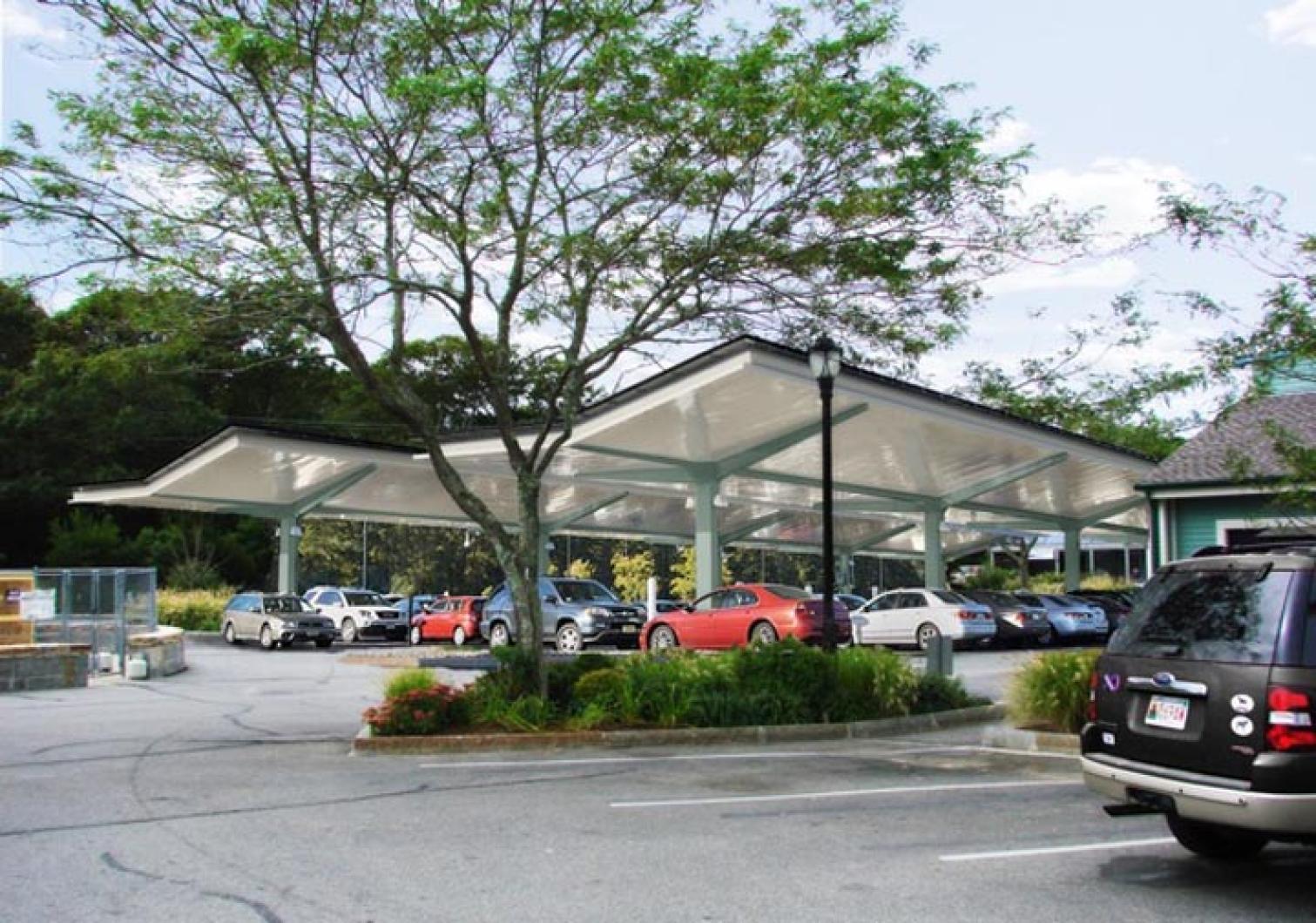Summer shoppers seeking shade may be able to do so this summer while powering up. Vineyard Power hopes to install a 12,200 square foot array of solar panels over the Vineyard Haven Cronig’s parking lot. The array, which will supply a quarter of the store’s energy needs, is made up of three “solar canopies,” which will also feature six electric car charging stations.
On Monday Cronig’s owner Steve Bernier, Vineyard Power Cooperative director Richard Andre and South Mountain Company president John Abrams met with the Martha’s Vineyard Commission for a pre-public hearing review of the $1.1 million, 210 kilowatt project. Vineyard Power is leasing the land from Mr. Bernier and contracting with South Mountain Company to install the canopies, which are manufactured by the New York-based Solaire Generation. Mr. Abrams said that his firm hopes to build the first two of the canopies over the Healthy Additions parking lot before the start of the summer. The final canopy will be built over the Cronig’s parking lot sometime this fall. According to Vineyard Power the project is being financed by local investors and loans from the Edgartown National Bank.
On Monday Mr. Abrams presented striking visual simulations of the plans.
“What we see as the most important impact is the visual impact,” he said. Mr. Abrams said his team hoped to paint the columns and decking of the canopies green and beige to make them more Vineyard appropriate.
Commissioner Fred Hancock said that the concern was well-placed.
“I think what people will say is it that reminds them of the Tisbury Shell canopy,” he said.
Mr. Abrams said that the project would serve as a powerful demonstration on an Island where available land is in short supply.
“One of the important aspects of this from the point of view of Vineyard Power is that it’s replicable that it demonstrate that we can use disturbed land [such as parking lots] to generate power,” said Mr. Abrams. “We see a disturbing trend to use agricultural land and habitat.”
The town of Edgartown is set to construct four acres of solar panels on agricultural land at Katama Farm. The land supports populations of the rare grasshopper sparrow and northern harrier. Mr. Abrams argued that the Island already had lower-impact resources available.
“Parking lots, as you know, are everywhere,” he said. “There are 4,000 square miles of them in the country. We’ve done a little calculation that just the large parking lots on the Island could produce about 30 times what [Cronig’s] will.”
Vineyard Power originally approached Mr. Bernier about installing solar panels on the roof of Cronig’s but quickly encountered engineering problems. On Monday Mr. Bernier spoke with the Gazette about how the project came together.
“They came back and said, ‘Gee, would you consider these canopies?’ And I said, ‘Wow, that’s different.’ I’d never really seen that effect and how that looked. It’s more structure, it’s more expensive but I think it’s a neat use of space. And to give some shade and rain coverage to people shopping, carrying groceries, I think that’s a beautiful blend.”
Vineyard Power is leasing the land from Mr. Bernier, who will in turn purchase the power from Vineyard Power. In 10 years Mr. Bernier will have the option to purchase the array, at which point the electricity would flow into the store at no additional cost. But Mr. Bernier says that he isn’t pursuing the project for financial reward.
“I’m not doing it for that,” he said. “Just the idea of helping to promote non-fossil-fuel transportation on Martha’s Vineyard, that’s a very soft benefit. It’s intangible in many ways but it’s a very tangible, beautiful goal to have for the future, and you have to participate in creating that.”
On Monday Mr. Andre said that the location was ideal and echoed Mr. Abrams’ environmental concerns.
“People ask why don’t you put them on roofs, but roofs aren’t big enough to do these projects,” he said. “It also doesn’t have us clearing woods or taking over agricultural land.”
While the Vineyard Power cooperative has been pursuing solar projects both at Cronig’s and the Aquinnah landfill, spurred by generous state and federal incentives, it hasn’t lost sight of its original dream of powering the Vineyard with wind. The Cronig’s project, if built, will produce a fifth of a megawatt. In the meantime Vineyard Power has partnered with Offshore MW LLC in the hopes of producing 1,000 megawatts in a vast swath of ocean administered by the federal government south of the Vineyard. Vineyard Power has estimated the Island’s energy needs at 43 megawatts.
“Solar’s always been part of our plan,” said Mr. Andre. “But the ultimate prize is the utility-scale offshore wind. We all know that.”






Comments
Comment policy »